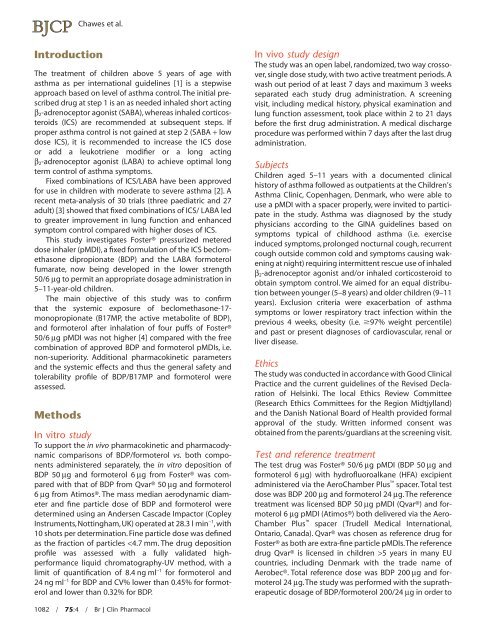Pharmacokinetic comparison of inhaled fixed combination ... - copsac
Pharmacokinetic comparison of inhaled fixed combination ... - copsac
Pharmacokinetic comparison of inhaled fixed combination ... - copsac
You also want an ePaper? Increase the reach of your titles
YUMPU automatically turns print PDFs into web optimized ePapers that Google loves.
Chawes et al.<br />
Introduction<br />
The treatment <strong>of</strong> children above 5 years <strong>of</strong> age with<br />
asthma as per international guidelines [1] is a stepwise<br />
approach based on level <strong>of</strong> asthma control.The initial prescribed<br />
drug at step 1 is an as needed <strong>inhaled</strong> short acting<br />
b 2-adrenoceptor agonist (SABA), whereas <strong>inhaled</strong> corticosteroids<br />
(ICS) are recommended at subsequent steps. If<br />
proper asthma control is not gained at step 2 (SABA + low<br />
dose ICS), it is recommended to increase the ICS dose<br />
or add a leukotriene modifier or a long acting<br />
b 2-adrenoceptor agonist (LABA) to achieve optimal long<br />
term control <strong>of</strong> asthma symptoms.<br />
Fixed <strong>combination</strong>s <strong>of</strong> ICS/LABA have been approved<br />
for use in children with moderate to severe asthma [2]. A<br />
recent meta-analysis <strong>of</strong> 30 trials (three paediatric and 27<br />
adult) [3] showed that <strong>fixed</strong> <strong>combination</strong>s <strong>of</strong> ICS/ LABA led<br />
to greater improvement in lung function and enhanced<br />
symptom control compared with higher doses <strong>of</strong> ICS.<br />
This study investigates Foster® pressurized metered<br />
dose inhaler (pMDI), a <strong>fixed</strong> formulation <strong>of</strong> the ICS beclomethasone<br />
dipropionate (BDP) and the LABA formoterol<br />
fumarate, now being developed in the lower strength<br />
50/6 mg to permit an appropriate dosage administration in<br />
5–11-year-old children.<br />
The main objective <strong>of</strong> this study was to confirm<br />
that the systemic exposure <strong>of</strong> beclomethasone-17-<br />
monopropionate (B17MP, the active metabolite <strong>of</strong> BDP),<br />
and formoterol after inhalation <strong>of</strong> four puffs <strong>of</strong> Foster®<br />
50/6 mg pMDIwasnothigher[4]comparedwiththefree<br />
<strong>combination</strong> <strong>of</strong> approved BDP and formoterol pMDIs, i.e.<br />
non-superiority. Additional pharmacokinetic parameters<br />
and the systemic effects and thus the general safety and<br />
tolerability pr<strong>of</strong>ile <strong>of</strong> BDP/B17MP and formoterol were<br />
assessed.<br />
Methods<br />
In vitro study<br />
To support the in vivo pharmacokinetic and pharmacodynamic<br />
<strong>comparison</strong>s <strong>of</strong> BDP/formoterol vs. both components<br />
administered separately, the in vitro deposition <strong>of</strong><br />
BDP 50 mg and formoterol 6 mg from Foster® was compared<br />
with that <strong>of</strong> BDP from Qvar® 50 mg and formoterol<br />
6 mg from Atimos®. The mass median aerodynamic diameter<br />
and fine particle dose <strong>of</strong> BDP and formoterol were<br />
determined using an Andersen Cascade Impactor (Copley<br />
Instruments,Nottingham,UK) operated at 28.3 l min -1 ,with<br />
10 shots per determination. Fine particle dose was defined<br />
as the fraction <strong>of</strong> particles 5 years in many EU<br />
countries, including Denmark with the trade name <strong>of</strong><br />
Aerobec®. Total reference dose was BDP 200 mg and formoterol<br />
24 mg.The study was performed with the supratherapeutic<br />
dosage <strong>of</strong> BDP/formoterol 200/24 mg in order to<br />
1082 / 75:4 / Br J Clin Pharmacol






